Nature Trip Blog
Recovered Red-shouldered Hawk gets a second chance at life
Getting Poisons out of S.F. Parks
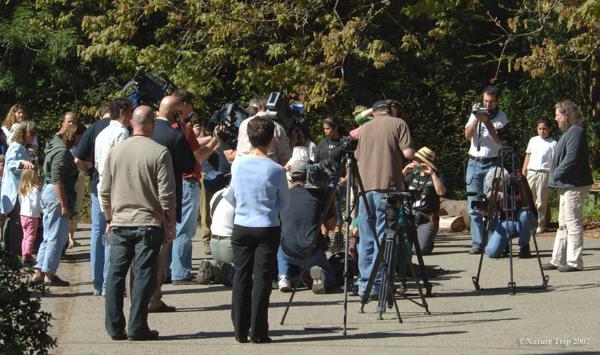 Here’s a follow up to the release on 3/16/2007 of the recuperated Red-shouldered Hawk that had been secondary poisoned by consuming a difethialone laden rodent in Golden Gate Park (GGP) six weeks prior.
Here’s a follow up to the release on 3/16/2007 of the recuperated Red-shouldered Hawk that had been secondary poisoned by consuming a difethialone laden rodent in Golden Gate Park (GGP) six weeks prior.
The release “party” on Friday was quite a scene with about 50 people including San Francisco employees, conservationists, schoolchildren and many reporters. A very well documented event indeed.
The March 16, 2007 SF Chronicle Jane Kay article can be found here: Jane Kay article
A Frederic Larson video of the release of the Red-shouldered hawk that was rehabilitated at WildCare in San Rafael can be found here: Frederic Larson video
Here’s an image of Melanie Piazza, Director of Animal Care at WildCare (Who, by the way ROCKS OUR WORLD!) just prior to releasing the “fully recovered” bird
The follow up story:
What a day for a Release Party – picture perfect weather!
We arrived to the SF Botanical Garden early – Another Red-shouldered Hawk flew overhead calling loudly and continually so we pointed it out to several of the media folks gathered
Deborah O. Raphael from the San Francisco Department of the Environment proclaimed a TEMPORARY moratorium on rodenticide use in the park. Jamie Ray from SF ROMP (pictured above far left) spoke about the issue of rodenticide use and the EPA public comment period
News cameras whirred, radio interviewers questioned and a group of children were thrilled to see such a magnificent bird at such close range Someone pointed out the gardener that had found the bird and she was thanked for turning in the bird to SF ROMP who transferred it to WildCare for recovery
Overheard one of the reporters confide “I can’t believe how emotional I’m getting about this”
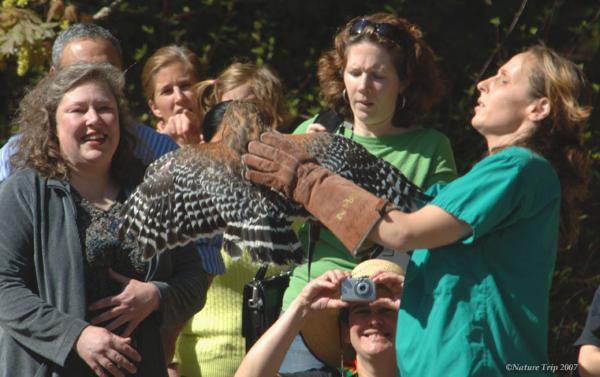
just prior to releasing the “fully recovered” bird
We briefly searched to see if it perched to preen nearby, but did not find it. About 15 minutes later we saw a Red-shouldered Hawk quickly flying overhead from the direction that the released bird had flown. It joined another Red-shouldered Hawk above the center part of the Arboretum. We suspect it may have been the bird that was calling earlier but there is no way to tell. We speculate (fantasize?) that the first calling Red-shoulder was the mate in waiting and somehow knew that it’s partner was in the cage below. But obviously there was know way for us to know that and our anthropomorphism meter lit up wildly
Melanie Piazza from WildCare did a great job speaking with reporters and keeping herself and the bird calm for the release with so many people around and cameras clicking. She spoke about the poison recovery method (Vitamin K IV) and why the bird was banded (so they would know if they came across it again).
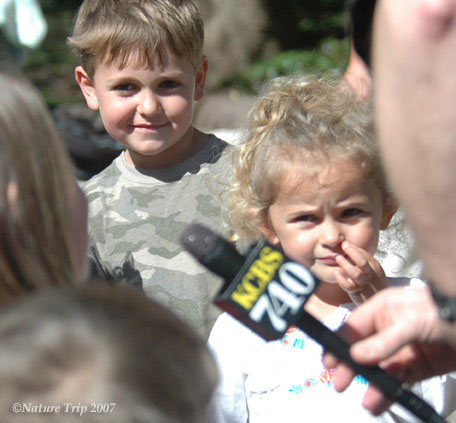
Thanks to our good friend Anne Ardillo of the Golden Gate Raptor Observatory for banding the bird
So, that sure was neat, but “Where do we go from here?”
For us we are hoping that the sad story of three hawks death due to rodenticide and this happy story of one hawk’s recovery may lead to better practices in dealing with problems like Norway Rats and the sooner the better
If you are interested, please read more below…
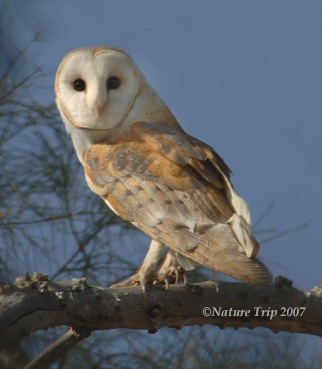
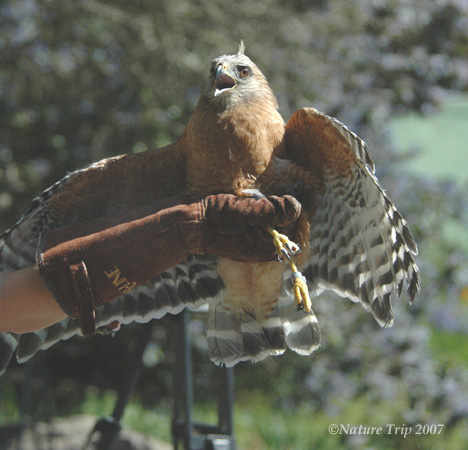
 A personal note: we’re very sympathetic to the gardeners and park staff who have to deal with rodent problems caused in large part by well meaning but uninformed residents and visitors. Gardeners, by nature are generally very caring people who love to see nature and life thrive.
A personal note: we’re very sympathetic to the gardeners and park staff who have to deal with rodent problems caused in large part by well meaning but uninformed residents and visitors. Gardeners, by nature are generally very caring people who love to see nature and life thrive.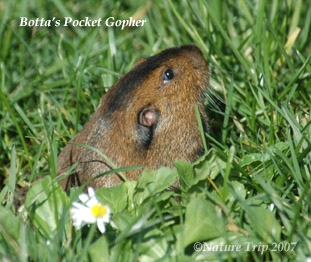
Putting them into the position of having to kill an invasive species that is causing a great amount of destruction (in this case Norway Rats) to their efforts does not sit well with them.
They are in a tough spot here so let’s try to help them out.
Open, frank discussions on the real and perceived problems the City is up against and implementation of the best, most humane practices that result from those is an ultimate goal.
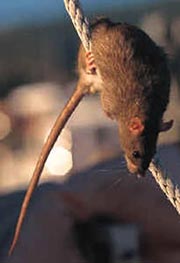 First, a little background –
First, a little background –
The problem with Norway Rats: The Norway Rat actually originated in Central Asia, not Norway. During the 16th and 17th centuries as trade between humans greatly increased it widely spread across Europe aboard trading vessels and overland. During the American Revolutionary War, Norway Rats arrived in America stowed away in boxes of grain on ships with Hessian troops hired by the British to fight the Colonists. Their ability to cause death and destruction to humans is very well documented. Occasionally referred to as our “closest urban competitor” they are major carriers of disease such as bubonic plague, spotted fever and typhus. They have been known to cause huge amounts of property destruction including fires (chewing on electrical cords), floods (tunneling through dams) and decimating human plant and food stores.
Hey, wait a minute! Not all rodents are bad rodents are they?
Nope: Another problem with the unfortunate introduction of Norway Rats is that they displace and kill native fauna that are key components in our natural and naturalized ecosystems. These systems need native rodents, birds, insects and plants in order to maintain a healthy balance.
Norway Rats, like all mammals need four things in order to live: air, water, food and shelter. Well, air and water have to be available for all life and shelter in a vegetation saturated park is pretty easy to come by but the big reason there is such a huge population in GGP as well as other areas in the City is the super abundance of food that humans make available to them.
1. Probably the number one food source in GGP that enable rats to multiply, well, like rats, is people feeding wildlife. One can stroll through the Botanical Garden on any given day and see dozens of people feeding squirrels, ducks, geese, gulls and even pigeons. In fact, after the Red-shoulder “release” party we documented eight people feeding wildlife in the SF Botanical Garden in only five minutes.
Of course, this behavior is against the law, but there is inadequate signage and zero enforcement of the ordinances associated with it. We asked them and most of these folks don’t even know it’s illegal
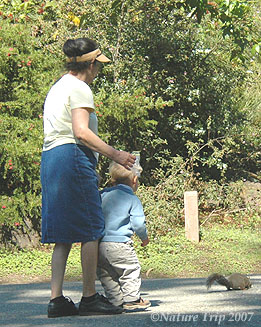 And truthfully who hasn’t enjoyed seeing a child’s eyes light up when one of these beautiful creatures approaches closely for a hand out?
And truthfully who hasn’t enjoyed seeing a child’s eyes light up when one of these beautiful creatures approaches closely for a hand out?
(See a proposed solution below)
So, where does all this food come from? We’ve documented five ways, so far:
2. Another, more controversial behavior enjoyed by a small minority of people that feeds Norway Rats is what many conservationists refer to as “the feral cat people”
This small, but very politically vocal group insists on setting up dozens of feral cat “feeding stations” throughout the park in order to feed the large quantity of abandoned and outdoor domestic cats that for lack of any other, call the parks there home or hunting ground.
Guess what, when night comes, the rats quickly clean out the feed stations and may share whatever diseases they carry on the hapless animals that share those dishes during the day. It’s not a good situation.
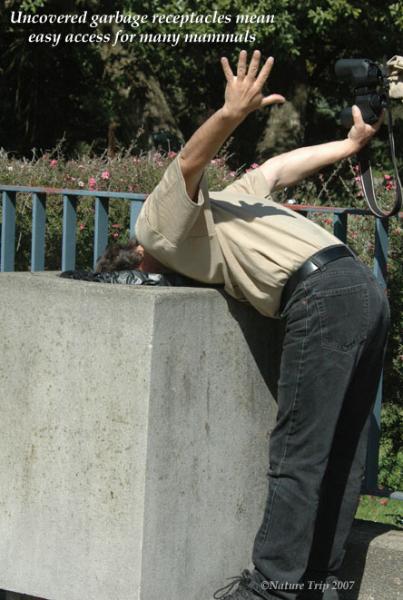 3. Unprotected refuse and garbage dumpsters: There are very few rat proof garbage cans in the park (some may say there is no such thing)
3. Unprotected refuse and garbage dumpsters: There are very few rat proof garbage cans in the park (some may say there is no such thing)
Most have no lids at all and visitors are not always as careful as they should be to make sure their garbage ends up safely inside. Spend a little time around one of the park dumpsters and you are sure to see a few Norway Rats scampering beneath
There are signs, but they are placed inconspicuously trying not to contrast with the aesthetics of the park and many people either don’t see them or are not English proficient enough to read them
The sign at right is approximately 1 foot square
A couple more issues, one very thorny:
4. Illegal camping in the park: No matter where you sit on the sad homeless problem in San Francisco one thing is for sure: Homeless camps are major magnets for rodent infestation.
5. Choice of plants: To a lesser degree the choices the GGP gardeners make on the flora they plant affects the rat equation. Cape Ivy is a well known favorite shelter and a plant that can quickly grow out of control. Fruiting plants while beneficial for many native fauna can also become an attractant. While I am in no way recommending that the fabulous and educational San Francisco Botanical Gardens flora be dramatically altered there are no doubt some changes in plant structure throughout the park that may offer less habitat suitable to Norway Rats.
Yeah, OK, but what about some practical solutions?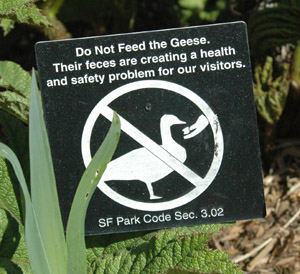
Well, this is where we’re hoping you may come in. From our work with the Hungry Owl Project, Golden Gate Raptor Observatory and the Golden Gate Audubon we’ve put a fair amount of time into thinking about these perplexing issues but we know there is much more. Already Dan Murphy (GGA Conservation Comm) came up with a great idea for the wildlife feeding issue we list below. Please, share yours!
The City has been mostly receptive to new ideas especially if they don’t cost much.
Anyway, we’ve separated known solutions to Norway Rat problems into three simple categories: that in our opinion are Bad, Better and Best:
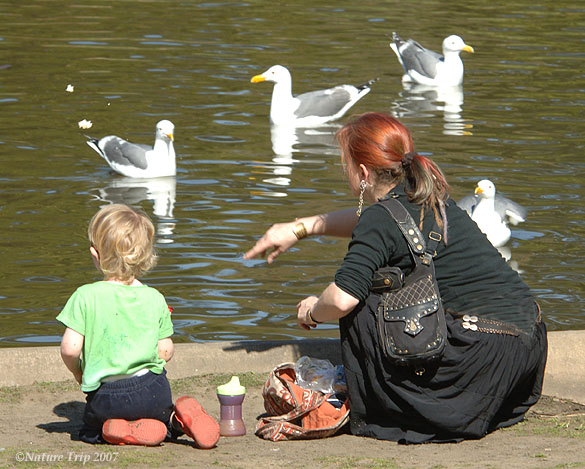 Another aspect of Norway Rat behavior that needs to be considered is that they are primarily a nocturnal species.
Another aspect of Norway Rat behavior that needs to be considered is that they are primarily a nocturnal species.
However as we’ve found out, when poisoned, Norway Rats are more likely to be caught out during the day by a hawk or falcon when in a poison stupor. Our guess is that we have lost more nocturnal raptors (Owls) than diurnal raptors due to rodenticide use in the park. The problem is, most all the feeding goes on at night and well out of the sight of visitors. If folks that were feeding wildlife saw rats devouring the food they were offering and running across the toes of their children then they would most likely stop that behavior. That’s not what many of them see, but that is what is happening.
The easy, but a bad solution:
Frankly, it’s hard to believe that we are still having conversations about getting poisons out of our food and ecosystems in 2007. The theories of food webs and chains were proven back in the 1960’s when scientists discovered DDT and other chlorinated hydrocarbons accumulated in fatty deposits of organisms and concentrated as they moved through the “food chain” causing death and disease not only to wildlife, but even to humans. Chlorinated hydrocarbons were eventually banned locally in the U.S. but are still persistent and sold by U.S. manufacturers in Central and South America where they are sometimes carried by migrating birds and insects back into the U.S. Note: Supporters of pesticide and rodenticide solutions offer that the side effects are worth it and the overall positive effects outweigh the negative impacts.
Less lethal but still highly dangerous poisonous concoctions are still widely available on store shelves without prescription and widely used by homeowners, businesses and government to combat pesky insects and rodents. Thousands of children in the U.S. each year are made seriously ill and some die due to accidental ingestion of these over the shelf poisons. The toll on wildlife and pets is tremendous but due to the difficulty and expense in detection, not as well known.
Suffice it to say, I think all reasonable people can agree it’s a serious modern concern.
So, why do poisons persist? First of all, it’s an easy out to a tough problem. In an outdoor situation the person placing the bait may never even see the Norway Rats. You put the poisons out, the Norway Rat population diminishes. Wildlife (and rarely humans) might die but so do the rats. What one might occasionally see is an animal that has ingested the poisons convulsing violently while it internally bleeds to death often leaving a trail of blood as it spends its last moments in excruciating pain often crawling into a dark space to succumb. Homeowners who have used rodenticides have described horrific scenes, coming home and finding trails of blood throughout their house and complaining that these results were not listed on the packaging.
Also, there is the huge multi-billion dollar chemical and pest control industry with very deep pockets and political muscle that has been fighting any laws that limit or eliminate use of pesticides and poisons. This is well documented so no need to go into details or name names here. Less discussed however is the effect these fights have had wasting time and funds that could be used to further research on more bio-friendly and ethical treatments to our rat problems
A better solution: A more ethical, low cost, less costly on the environment, albeit somewhat unappetizing solution lies in live trapping and killing the target invasive Norway Rats. With this method ecosystem valuable native species that are incidentally trapped can be set free and only the Norway Rats are destroyed. Baited snap traps which target and generally instantly kill Norway Rats are less effective and easier for the trappers to deal with but incidental killings of non-target species will occur.
The best solution – Updating and fully implementing a Natural, Integrated Pest Management approach:
1. Removal of the super abundant food sources offered by humans is the fundamental first step to implementing an Integrated Pest Management strategy
a. Signage and enforcement of “no feeding of wildlife” ordinances
b. Removal of feeder stations
c. Installing rat-resistant refuse containers
d. Evaluating plantings from a pest food value perspective.
Easier said then done of course, each of the steps above requires some funding and the first two steps are going to be challenged by the aforementioned groups. Public and wildlife health concerns easily trumps these group’s challenges but that has not stopped them from mounting legal and illegal hurdles that will frustrate and attempt to intimidate city workers. One suggestion that has already been made by a member of the Golden Gate Audubon Conservation Committee to ameliorate the well meaning wildlife feeders is to have areas set aside just for that purpose. Folks would be able to purchase more appropriate food for the particular animals they want to feed (rather than the wildlife “junk food” that is more often the case) and the proceeds from that could go towards end of day cleaning of that area to remove food that the Norway Rats would consume at night.
2. Encouraging natural predators. Both diurnal and especially nocturnal raptors are probably hands down human’s best friends at Norway Rat control. It is estimated that a single Barn Owl family of two adults and five owlets can consume up to 3,000 rodents in a single season. Diurnal raptors (Hawks and Falcons) also greatly contribute to this score. The primary diet of somewhat more controversial urban predator species including coyotes and foxes is also rodents. Note: Unfortunately our handsome native Gray Fox species is being usurped in many areas by yet another human introduced species (this one introduced on purpose, for hunting), the larger Red Fox which is causing problems for some of our threatened and endangered birds. As mentioned above, we have probably lost many of our owls to rodenticide use. We have had very low counts of Great Horned Owls in GGP on the last few Christmas Bird Counts and no Barn Owls have been detected. There is appropriate habitat, so we suspect they are being poisoned. Also, nest box programs for Barn and Screech Owls work. The Hungry Owl Project in Marin has probably doubled the number of Barn Owls (a species that is dramatically declining in many other regions in the U.S.) by convincing ranchers, vineyard and home owners to install Barn Owl boxes and agree to not use poisons on their property.
RESOURCE: www.hungryowl.org
3. The illegal camping is of course a much stickier wicket and I’ll leave that one to folks that are much
more informed than I about how best to deal with this huge ongoing problem.
Wow, if you’ve read this far then you must be interested in helping solve the problem or else your mad as hell. Hope it’s the first of those and that you may have an idea to share.
Personally we have nothing at stake here other than our love of wildlife and we are especially fond of raptors
If you would like to comment on this journal or share your brilliant idea please click here:
IDEAS & COMMENTS
Copyright Notice: All photography and text is property of Nature Trip and is not to be used, copied or reproduced without permission.

Sorry, comments are closed for this post.